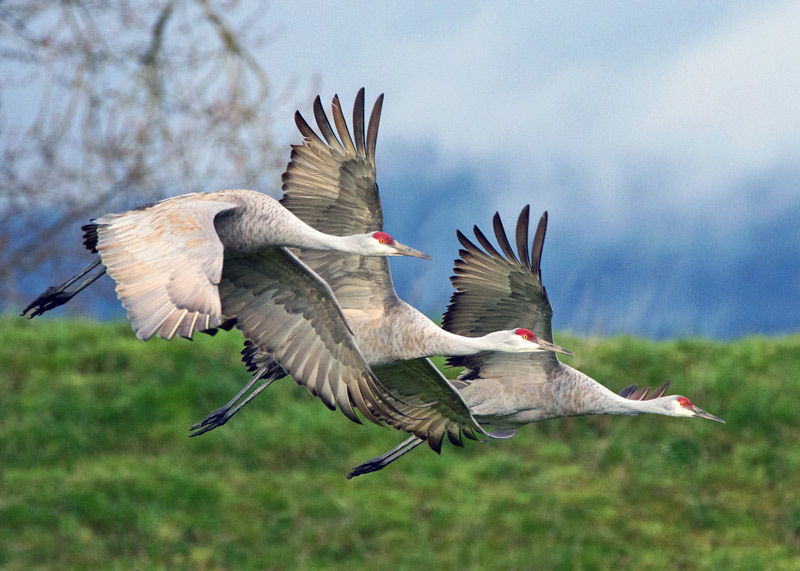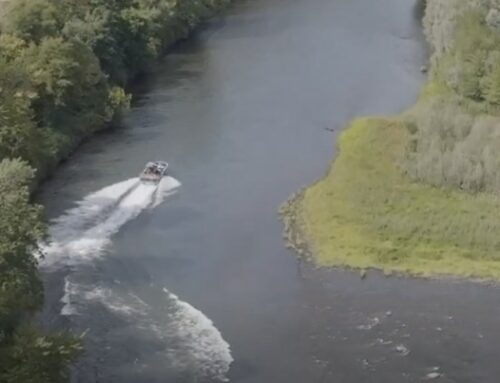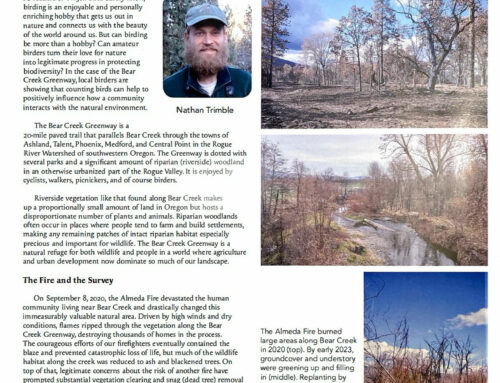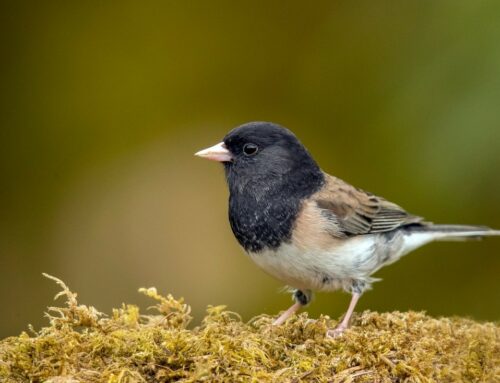Date: March 19, 2020
From: Audubon Society of Portland
To: US Fish and Wildlife Service
Re: Docket No. FWS-HQ-MB-2018-0090, Proposed Rule and Environmental Impact Statement for Migratory Bird Treaty Act
Dear US Fish and Wildlife Service,
Please accept the following comments from Audubon Chapters in Oregon including Audubon Society of Portland, East Cascades Audubon Society, Salem Audubon Society, Kalmiopsis Audubon Society, Umpqua Valley Audubon Society, Cape Arago Audubon Society, Ten Mile Creek Sanctuary (Yachats), Audubon Society of Lincoln City, Klamath Basin Audubon Society, Rogue Valley Audubon Society and Corvallis Audubon Society regarding the US Fish and Wildlife Service’s (USFWS) Proposed Rule and Environmental Impact Statement (EIS) for the Migratory Bird Treaty Act (MBTA). We strongly oppose the proposed rule which would conflict with the purpose of the Migratory Bird Treaties that form the basis for the MBTA, eliminate critical protections for migratory birds provided by the MBTA and put North American bird populations at significantly increased jeopardy. We urge the US Fish and Wildlife Service to reject the proposed rule and select the “no action” alternative in the EIS.
Background
The Migratory Bird Treaty Act of 1918 implements four international treaties signed by the United States with Great Britain on behalf of Canada (1916), Mexico (1936), Japan (1974) and Russia (1978) designed to protect North American bird species. Although the treaties move progressively from a primarily utilitarian focus to more spiritual, moral and aesthetic justification, at the core of all four treaties is a clarion call to reverse the growing threat of species extinction. The spirit of these treaties is captured in the 1916 Treaty with Great Britain which reads:
Whereas, many species of birds in the course of their annual migrations traverse certain parts of the United States and the Dominion of Canada; and whereas many of these species are of great value as a source of food or in destroying insects which are injurious to forests and forage plants on the public domain, as well as to agricultural crops,…but are nevertheless in danger of extinction of extermination though lack of adequate protection during the nesting season or while on their way to and from their breeding grounds; The United States and…Great Britain…being desirous of saving from indiscriminate slaughter and of insuring the preservation of such migratory birds as are either useful to man or are harmless, have resolved to adopt some uniform system of protection…”1
Subsequent treaties with Mexico, Japan and Russia reaffirmed the commitment to prevent extinction of migratory bird species. The 1936 Convention between the United States and Mexico reads, “Whereas it is right and proper to protect the said migratory birds…in order that the species not be exterminated…”2 The treaty with Japan signed in 1974 offers as its purpose a statement, “…that birds constitute a natural resource of great value for recreational, aesthetic, scientific, and economic purposes, and that this value can be increased with proper management…and… that many species of birds in the Pacific Islands have been exterminated, and that other species are in danger of extinction…”3 The 1978 treaty with Russia offers the most robust justification for protection stating that migratory birds are “a natural resource of great scientific, economic, aesthetic, cultural, educational, recreational and ecological value…and…certain species of birds in both countries are endangered and in need of particular protective measures.”4
The Migratory Bird Treaties are codified under 16 U.S.C. §703-712 (The Migratory Bird Treaty Act of 1918 (MBTA)). The MBTA prohibits “all killing or possession and all commercial activity in migratory birds and instead authorizes the Secretary to promulgate regulations providing for the issuance of permits exempting conduct from this “general prohibition.”5 The opening lines of the act state:
Unless and except as permitted by regulations…it shall be unlawful at any time by any means or in any manner, to pursue, hunt, take, capture, kill, attempt to take, capture or kill, possess, offer for sale, sell, offer to barter, barter, offer to purchase, purchase, deliver for shipment, ship, export, import, cause to be shipped, exported or imported, deliver for transportation, transport, cause to be transported, carry, or cause to be carried, or receive for shipment, transportation, carriage, or export, any migratory bird, or any part, nest or egg of any such bird included in the terms of the conventions.”6
§704 of the MBTA allows the Secretary of the Interior to issue permits to “take” protected bird species based on the Secretary’s determination that take is compatible with the Treaties objectives. Section 704 reads:
The Secretary of the Interior is authorized and directed, from time to time, having due regard to the zones of temperature and to the distribution, abundance, economic value, breeding habits, and times and lines of migratory flight of such birds, to determine when, to what extent, if at all, and by what means, it is compatible with the terms of the conventions to allow hunting, taking, capture, killing, possession, sale, purchase, shipment, transportation, carriage, or export of any such bird, or any part, nest, or egg thereof, and to adopt suitable regulations permitting and governing the same, in accordance with such determinations, which regulations shall become effective when approved by the President…7
Under 50 C.F.R §10.12 “take” is further defined as “pursue, hunt, shoot, wound, kill, trap, capture, or collect or attempt” to do the same.8 50 C.F.R. 21(1)-(30) specifically the permitting component of the MBTA and provides provisions for categories of “take” permits including import/ export, banding, scientific collecting, taxidermy, waterfowl sale, falconry, raptor propagation and special use.9 50 C.F.R. §13.21(b)(4) specifically requires that FWS may not issue a permit which potentially threatens a wildlife…population.”10
The scope of the MBTA including its application to both intentional and incidental take of protected species was captured in 1938 by the District Court of Tennessee when it held in US v. Reese the following:
The high purpose of the high contracting parties in the Migratory Bird Treaty to protect these feathered friends of mankind against extermination might be utterly defeated by a narrow construction of the intent of Congress….Mal prohibita statutes without enforceable penalties would utterly fail of their beneficent purpose…The deduction is plain that Congress deliberately omitted scienter as an essential ingredient of the minor offense under consideration…This concept is logical in the light of the known practicality of the National Legislature in its enactments in support of the Migratory Bird Treaty. Congress clearly intended to make real the protection against the holocaustic slaughter of migratory birds.11
The reach of the MBTA covering incidental take was perhaps best articulated by the Second Circuit in United States v. FMC Corporation where the court held that a company that manufactured toxic pesticides could be held liable for a misdemeanor violation of the MBTA for pumping contaminated water into a pond and inadvertently killing protected bird species. Although the court explicitly recognized that FMC was “not aware of the lethal-to-birds quality of the water in its pond,” the fact that FMC “engaged in an activity involving the manufacture of a highly toxic chemical; and FMC failed to prevent this chemical from escaping into the pond and killing birds” was sufficient to impose strict liability.” While the court recognized that this argument taken to its extreme could result in situations “that would bring every killing within the statute” the court remained undaunted by this possibility, asserting that “an innocent technical violation on the part of any defendant can be taken care of by the imposition of a small or nominal fine. Such situations can properly be left to the sound discretion of prosecutors and the courts.”12
Until late 2017, the Department of the Interior and the USFWS interpreted the MBTA to apply to both intentional and incidental take of avian species protected under the MBTA. The implications of this interpretation for the protection of avian species is profound. The threat of prosecution under the MBTA has allowed USFWS to promote major reforms in industrial activities posing major threats to protected bird species. This has included: retrofitting of power lines causing avian electrocutions, covering of open oil pits that attract birds, removal of pesticides from the market, siting of wind farms outside of migratory corridors, etc. It has allowed the USFWS to hold industries accountable when their activities result in major incidental avian mortality events, for example oil spills such as the Exxon Valdez, Deepwater Horizon and New Carissa. Finally, it has given USFWS leverage to work with a wide array of entities to proactively adopt policies and practices that are protective of wild birds. In Oregon examples include: The City of Portland’s Best Management Practices for Protecting Nesting Birds During Vegetation and Construction Projects,13 City of Portland Bird Friendly Building Guidelines14 and municipal code15, Oregon Department of Transportation’s Peregrine Falcon Management Plan16 and the Portland International Airport Wildlife Hazard Management Plan17.
In December 2017, the Trump Administration Department of the Interior turned a century of precedent on its head when it adopted Solicitor’s Opinion M- 37050 which advised no longer applying the protections of the MBTA to incidental take18. In doing so, the Trump Administration not only turned its back on a century of avian conservation effort, but reversed another Solicitor’s Opinion written just eleven months earlier, in January 2017 which upheld a century of interpretation that the MBTA does in fact apply to incidental take. In January 2017, the DOI Solicitor wrote:
I explain in detail below the basis for FWS’ s interpretation of the MBT A, analyzing in turn the text and legislative history of the MBTA, the four treaties underlying the statute, the past agency practice of the FWS in implementing the law, and the relevant case law. In sum, the MBTA’s broad prohibition on taking and killing migratory birds by any means and in any manner includes incidental taking and killing. Moreover, the prohibitions of the MBTA, as informed by the underlying treaties, are not limited to hunting, poaching, or any particular factual context; rather, they extend generally to unauthorized take or killing of migratory birds, including take that is incidental to industrial or commercial activities. The MBTA imposes strict liability (with narrow exceptions) for misdemeanor violations resulting from unauthorized take, incidental or otherwise. Therefore, the government need not show that a defendant willfully or intentionally took or killed birds to prove a violation of the MBT A. Liability under the MBTA is bounded by limits of proximate causation, however, and applies to “direct” take where there is a close causal connection between an action and its effect of taking migratory birds.19
The Trump Administration now seeks to codify an erroneous, irresponsible and ecologically devastating opinion into a rule that flagrantly undermines the international treaties which provide the foundation for the MBTA, reverses more than 100 years of avian conservation effort, and which will propel already imperiled avian species closer to extinction.
The Proposed Rule and accompanying EIS should be abandoned
Audubon Chapters in Oregon urge the USFWS in the strongest possible terms to abandon the proposed rule and accompanying EIS. This rule represents a fundamental abdication of the US Fish and Wildlife Service’s mission to protect native wild birds. There is simply no question that the US Fish and Wildlife Service’s history of interpretation (until 2017) of the MBTA as applying to incidental take has been the bulwark protecting tens of millions of birds from unnecessary deaths. The proposed rule would allow industries that have reformed their bird killing activities to immediately revert to past lethal practices and cripple efforts to proactively address emerging incidental threats. It is deeply troubling to already see the USFWS already signaling to industrial and commercial interests that there will be no accountability when their activities result in incidental take.20
1. North American Birds are deeply imperiled
The proposed rule comes at a time when research clearly demonstrates that North American bird populations are already facing dire circumstances. In September, 2019, the Cornell Lab of Ornithology published a report entitled “Decline of North American Avifauna”21 in Science reporting a decline of nearly 3 billion breeding birds North America across every North American biome since 1970. This represents a nearly 30% decline in bird populations over the past five decades. The report used a variety of standardized long-term data sets to estimate population changes in 529 North American bird species as well as weather radar (NEXRAD) to estimate changes in biomass of night migrating birds in order to arrive at this estimate. The researchers found that 57% of the species reviewed are experiencing long- term declines, including not just species that are considered imperiled, but also many avian species that are still considered common.
In October 2019, the National Audubon Society published a report entitled “Survival by Degrees: 389 Bird Species on the Brink”22 reporting that a 3 degree Celsius rise in temperatures would threaten two thirds of North American bird species with extinction over the next century. National Audubon used more than 140 million bird records from more than 70 data sources as well as sophisticated modeling of current and projected future habitat availability under different climate change scenarios to arrive at this conclusion.
These reports come on top of years of NABCI State of the Birds Reports23 which reached similarly dire conclusions. The 2019 State of the Birds Report concludes:
According to a recent analysis, nearly 30% of all North American birds have disappeared in the last 50 years. New research published in the journal Science shows massive losses among U.S. bird populations—with steep declines in every habitat.…But Recovery Is Possible When We Invest in Birds. Look no farther than the national bird of the United States. In 1970 only a few hundred Bald Eagle pairs remained in the lower 48 states. Federal and state protections sparked a remarkable recovery. The Bald Eagle was delisted as an Endangered Species in 2007, and today 30,000+ eagle pairs live in the U.S.A. We can achieve similar successes with other precious species.
The decline of North American wild birds over the past several decades should be a clarion call for doubling down and expanding existing protections, not abandoning one of the most powerful regulatory mechanisms that USFWS currently has at its disposal.
2. The ability To regulate incidental take is a critically important tool for conserving wild birds
While the MBTA does not directly protect avian habitat, it does provide baseline protection for more than 1,000 native bird species against both intentional and incidental anthropogenic causes of mortality. Incidental take represents a very substantial portion of the overall avian mortality in the United States. The US Fish and Wildlife Service estimates that leading incidental causes of mortality (excluding habitat loss and fragmentation, cats and vehicles) currently results in between 453,140,438 and 1,136,827,586 bird deaths annually.24 If the Fish and Wildlife Service allows entities that are currently taking steps to reduce bird mortality to revert to prior practices and is restricted from utilizing this tool to address emerging threats, those numbers would skyrocket.
Additionally, the incidental take provisions of the MBTA result in the protection of an incalculable number of wild birds through undocumented steps that businesses, industries, agencies, governmental entities and private individuals take each day to comply with the MBTA incidental take provisions. While it is fair to say that much of the US population is unaware of the technical details of the MBTA, it is also fair to say that there is a widespread generalized understanding that killing wild birds either, intentionally or incidentally, is not permitted by law. At Audubon, we are contacted on a daily basis by individuals and entities calling to find out what they need to do to protect wild birds. We are also contacted on a daily basis by individuals and entities concerned that some other entity is harming wild birds. This generalized understanding that wild native birds are protected from taking results in myriad decisions each and every day where entities chose a course of action that is protective rather than harmful to wild birds. These decisions range from an individual property owner’s decision not to trim their shrubs during nesting season to altering the timing, scale and scope of large construction projects. It underpins political decisions such as those made by the City of Portland to adopt bird-safe building requirements, reduce light pollution, adopt BMPs governing landscaping during nesting season, and banning the use of avicides on City property.
We also see the impacts of the MBTA incidental take provisions at our Wildlife Care Center which works hand in hand with the US Fish and Wildlife Service. Portland Audubon’s Wildlife Care Center is the oldest rehabilitation center in the United States and the busiest rehabilitation center in Oregon. Each year, the Care Center handles upwards of 3,000 wildlife intakes and 15,000 wildlife related phone inquiries. The incidental take provision of the MBTA is critical to helping us prevent unnecessary harm to birds protected under the MBTA and to address situations where significant harm has occurred. We have always been impressed with the US Fish and Wildlife Service’s adept use of the MBTA incidental take provisions to, in most cases gently nudge entities to protect birds, but where necessary to move to enforcement to address significant sources of incidental harm.25
The incidental provisions of the MBTA drive a culture of protection of wild birds. They allow the USFWS to directly and strategically address significant, ongoing and persistent sources of incidental take and promote a culture of bird protection and conservation. USFWS has been extremely conservative in its enforcement of the incidental take provisions of the MBTA, but that limited enforcement underpins a much broader culture of voluntary protection. Elimination of the incidental take provisions of the MBTA would have massive implications for the ability to protect already seriously declining bird populations in the United States that go far beyond the elimination of enforcement actions actually taken by the USFWS. It would shift the US from a culture of protection of wild birds to a culture of wanton permissiveness to harm them.
3. The decline of North American bird species poses a fundamental threat to the ecological health and economy of the United States
Wild native birds are critical to the ecological health and economic prosperity of the United States. Beyond their incalculable intrinsic value, they also provide critical ecological services including pest control, seed dispersal, pollination, scavenging, support human health and disease prevention, ecosystem engineering, are an integral part of the food chain and myriad other benefits. As was recognized more than a century ago in the original Migratory Bird Treaty with Great Britain, birds are essential to our agricultural sector. Birds are the proverbial “canary in the coalmine” and allowing populations to continue to plummet creates ecological risks that go far beyond the loss of the birds themselves.
Birds also drive a tremendous amount of economic activity. A partial catalogue of the economic contributions of birds to the US economy includes the following: The USFWS estimates that birdwatching generates a total economic output of $107 billion and is associated with a total of 666,000 jobs, resulting from direct expenditures of $41 billion annually, and leading to $31.4 billion in employment income, and $13 billion in state and federal tax revenue.26 The 2016 US Fish and Wildlife Service National Survey of Fishing, Hunting and Wildlife-associated Recreation found that 57 million people in the United States engage in backyard bird-feeding, spending over $4 billion/ year on birdfood.27 Hunting of migratory birds provides an additional economic output of $7.6 billion and is associated with 69,000 jobs, from a direct contribution of $3.4 billion annually, and leading to $2.4 billion in employment income and $508 million in state and federal tax revenue.
4. It appears that the USFWS has allowed regulatory entities to rewrite the rules
It is deeply troubling that the US Fish and Wildlife Service included in its announcement of the proposed rule, a series of twenty-eight “What they are saying” quotes from regulated industries, conservative politicians and rightwing foundations. This approach gives the publication of the review the gravitas of a movie or restaurant review rather than the seriousness that it merits. A rule impacting hundreds of millions of wild birds should be driven by law, science and mission, not a popularity contest among regulated entities. The inclusion of these quotes from entities such as the Wyoming Stock Growers Association, National Ocean Industries Association, American Farm Bureau Federation, National Association of Homebuilders, American Energy Alliance, and US Chamber of Commerce raises serious questions about undue influence by the very industries against which MBTA enforcement has been pursued to reduce mortalities of protected birds. It appears that the US Fish and Wildlife Service has allowed regulated industries to write their own rules exempting themselves from coverage. The inclusion of these quotes makes a mockery of the rulemaking process indicating that the US Fish and Wildlife Service has abdicated its authority to the very industries it most needs to regulate and that this process is nothing more than a charade.
5. Timeline
The US Fish and Wildlife Service has indicated that it plans to complete the entire NEPA process and reach a final record of decision (ROD) and final rule by fall of 2020. This is an extraordinarily short timeline of less than ten months to proceed from initial scoping to final rule. It is difficult to imagine any scenario under which the federal agencies could review and give serious consideration to the comments it will receive on this proposed rule, let alone incorporation of them into a FEIS, ROD and final rule.
Further concerns are raised by the fact that the USFWS has chosen the unorthodox approach of simultaneously publishing a draft rule and an NEPA scoping announcement and seeking comments on both at the same time. It strongly suggests that USFWS has already reached a conclusion about the outcome of this process and that the NEPA process is nothing more than a formality. Under normal NEPA EIS process, federal agencies would conduct scoping of an issue, develop multiple action alternatives, put those alternatives out for public notice and comment, and ultimately select an alternative to advance. In this case, the USFWS appears to have already selected the outcome it intends to reach at the scoping phase. We simply do not believe that the USFWS can conduct a credible NEPA process based on the timeline and chronology it has presented at this point. The credibility of this process has already been fatally damaged by the way in which the USFWS has proceeded.
6. NEPA Environmental Impact Statement Scoping:
USFWS presents three “action alternatives” plus a “no action alternative” (status quo) as part of the NEPA EIS scoping process associated with the proposed rule. The three action alternatives are as follows:
- Alternative A: promulgate regulations to define scope of MBTA regarding incidental take consistent with M-37050
- Alternative B: Develop a permit system to regulate incidental take (including rescinding M-37050)
- Alternative C: Develop an enforcement system to address gross negligence including rescinding M-37050opinion. And promulgate regulations to define scope of MBTA under a gross negligence standard
As already noted, the publication of the proposed rule alongside glowing endorsements from regulated industries has already fatally damaged the credibility of this process. USFWS’ objective here appears to be to check the NEPA box rather than conducting the “hard look” required under NEPA. Our recommendation, to the degree the NEPA process moves forward at all, is to select the “No Action
Alternative.” All three of the action alternatives fundamentally undermine protections for native migratory birds in the United States. Alternative A (the proposed rule) eliminates incidental take altogether from the MBTA. Alternative B proposed developing a permit system to regulate incidental take. While we tentatively support the creation of an incidental take permit under the MBTA, we question why it would be done in this type of process as opposed to via the Migratory Bird Protection Act, H.R. 5552 which is already before Congress. Alternative C severely narrows the definition of incidental take from all incidental take to only take that meets a gross negligence standard. Gross negligence is a very high standard to meet requiring “extreme indifference” or “reckless disregard.” This standard would eliminate USFWS’ ability to address the vast majority of incidental take impacting wild birds.
7. The US Fish and Wildlife Service should consider incidental take permits as a strategy to provide more certainty to entities concerned about liability for incidental take
We believe that the US Fish and Wildlife Service has done an admirable job of using its discretion in terms of enforcing the incidental take provisions of the MBTA. Enforcement actions have been rare and typically restricted to incidents that were egregious or in which entities have been put on clear notice of violations. The record shows that in many cases, industries were given years and even decades to come into compliance. The most aggressive advocates for abandoning the incidental take provisions of the MBTA are industries, many of which are quoted in the “What they are saying” section of the of the federal notice for this rulemaking, that kill large numbers of migratory birds and which have been given more than fair warning about their ongoing violations. They advocate for eliminating the incidental take provisions not because they have faced unfair or unpredictable enforcement actions, but rather because they have been held accountable for their impacts.
That being said, to the degree that uncertainty can be alleviated, we do support consideration of development of an incidental take permit under the MBTA. We believe that the Migratory Bird Protection Act (H.R. 5552) is the appropriate vehicle to advance this objective.
Conclusion
We appreciate your consideration of these comments. Protecting wild native birds is a fundamental part of the core mission of the US Fish and Wildlife Service. Wild birds are facing a bleak future unless we dramatically increase both regulatory and non-regulatory strategies to protect and recover species. At a time when the US Fish and Wildlife Service should be stepping up, it is instead proposing to abdicate its core mission. The December 2019 solicitor opinion, proposed rule and EIS alternatives take us exactly in the wrong direction. The federal government is proposing to turn back more than a century of precedent and to turn its back on wild migratory birds. We believe that the solicitor’s opinion M-37050, which catalyzed the current process, was deeply flawed and at odds with the Migratory Bird Treaties with Britain, Mexico, Russia and Japan, The Migratory Bird Treaty Act of 1918, and the vast majority of case law.
We recommend:
- Rescind Solicitor’s Opinion M-37050;
- Reject the proposed rule;
- Terminate the NEPA process;
- To the degree that there is concern about uncertainty for potentially regulated entities under MBTA incidental take provisions, prioritize advancing the Migratory Bird Protection Act, H.R. 5552;
- Immediately restore USFWS’ ability to enforce incidental take protections under the MBTA.
Please abandon the proposed rule and associated NEPA process. Thank you for your consideration of these comments.
Respectfully,
Bob Sallinger Conservation Director
Audubon Society of Portland
Harvey Shuboth President
Cape Arago Audubon Society
Paul Engelmeyer Manager
Ten Mile Creek Sanctuary (Yachats)
Ann Vileisis President
Kalmiopsis Audubon Society
David Harrison
Conservation Chair Salem Audubon Society
Stan Vejtasa Conservation Chair
Umpqua Valley Audubon Society
Gordon Wetzel Vice-president
East Cascades Audubon Society
Steve Griffiths Conservation Chair
Audubon Society of Lincoln City
Darrel Samuels President
Klamath Basin Audubon Society
Bill Proebsting President
Corvallis Audubon Society
Carol Mockridge President
Rogue Valley Audubon
Endnotes
1 Convention between the United States and Great Britain for the Protection of Migratory Birds. 39 Stat. 1702 (1916).
2 Convention between the United States of America and the United Mexican States for the Protection of Migratory Birds and Game Mammals 50 Stat. 1311 (1936).
3 Convention between the Government of the United States of America and the Government of Japan for the Protection of Migratory Birds and Birds in Danger of Extinction, and Their Environment. 25 U.S.T. 3329 (1974) 4 Convention Between the United States of America and the Union of Soviet Socialist Republics Concerning the Conservation of Migratory birds and The Environment. 29 U.S.T. 4647 (1978).
5 Dale D. Goble and Eric T. Freyfogle. Wildlife Law: Cases and Materials 856 (1st ed. Foundation Press. 856 (2002).
6 16 U.S.C. §703.
7 16 U.S.C. § 704.
8 50 C.F.R. §10.12.
9 50 C.F.R. §21 (1)-(30).
10 50 C.F.R. §13.21(b)(4).
11 United States v. Reese, 27 F. Supp. 833, 835 (W.D.Tenn. 1939).
12 United States v FMC Corporation, 572 F.2d 902 (2nd Cir. 1978).
13 https://www.portlandoregon.gov/bes/index.cfm?a=322164
14 https://www.portlandoregon.gov/bds/article/408796
15 https://www.portlandonline.com/shared/cfm/image.cfm?id=53363
16 https://www.nrc.gov/docs/ML1428/ML14286A067.pdf
17 https://popcdn.azureedge.net/pdfs/Env_WildfireHzdMgtPrgm_PDX.pdf
18 https://www.doi.gov/sites/doi.gov/files/uploads/m-37050.pdf
19 https://www.eenews.net/assets/2017/02/21/document_ew_01.pdf
20 https://www.nytimes.com/2020/01/30/climate/trump-bird-deaths.html
21 https://science.sciencemag.org/content/366/6461/120
22 https://www.audubon.org/climate/survivalbydegrees
23 https://www.stateofthebirds.org/2019/
24 https://www.fws.gov/birds/bird-enthusiasts/threats-to-birds.php
25 As this section of this comment letter was being written, the following email came in which is typical of the type of communications we see multiple times per day: Hello I am sorry I cannot figure out who I am supposed to contact I was on hold for a long time (no worries I know how busy you guys are) so I am just trying my best. Two days in a row _____________ has been removing berry bushes along the banks of Hayden Island where the hummingbirds nest. Erika is the manager of the manufactured home community _______________ that hired ______________________________. I have called notified both offices and they continue to destroy the habitat. I don’t know the exact address where the bushes are being removed but it is just across the bank from our floating home which is _____________. Please help – thank you very much. Sincerely, ______________
26www.fws.gov/southeast/pdf/report/birding-in-the-united-states-a-demographic-and-economic-analysis.pdf
27https://www.fws.gov/wsfrprograms/Subpages/NationalSurvey/nat_survey2016.pdf







Leave A Comment
You must be logged in to post a comment.